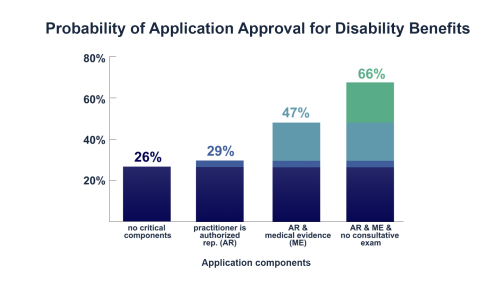For those with disabilities and in precarious living situations, challenges accessing disability supports are often compounded by the nature of their disabilities, which frequently include mental health and substance abuse disorders and a lack social and familial support. An evaluation by Mathematica Policy Research found that these challenges were somewhat mitigated by an initiative of the Substance Abuse and Mental Health Services Administration (SAMHSA) that aims to help them file a complete and high-quality benefit application. The initiative, known as the Supplemental Security Income (SSI)/Social Security Disability Insurance (SSDI) Outreach, Access, and Recovery (SOAR) initiative, is intended to increase disability benefit access among homeless and at-risk individuals by promoting collaboration among agencies serving this population and by training professionals in specific practices to improve the quality of SSI and SSDI applications.
An evaluation of the SOAR initiative, conducted for SAMHSA by Mathematica, found that when practitioners provide application assistance using concepts from the SOAR model, they achieve better outcomes for their clients and increase communication among entities involved in the application process for disability benefits.
Specific findings include:
- SOAR practitioners reported a 73 percent application approval rate
- SOAR participants had significantly higher approval rates compared to non-SOAR participants
- Among homeless applicants, the odds of benefit approval at the initial level was 130 percent higher for those who had gone through the SOAR process, compared with those who had not
- Using an authorized representative, submitting medical evidence with the application, and submitting a complete application that eliminates the need for a consultative exam are predictive of higher initial application approval rates alone and in combination. The likelihood, on average, that an initial SSI or SSDI application will be approved is 66 percent if all three of these practices are followed, compared with 26 percent if none are followed.
Despite the positive outcomes associated with SOAR, findings from Mathematica’s evaluation indicate that most professionals who are trained never use the model in practice. In less than three years, 563 people in 13 communities studied were trained in the SOAR model, but only about 13 percent went on to help people complete and submit disability benefit applications using the SOAR process. Mathematica’s evaluation identified several factors that contribute to this low take-up rate:
- Training is frequently provided to administrators, rather than targeted to practitioners who can directly assist with applications.
- Many practitioners, who typically carry large caseloads, do not have time to assist with applications, which can take 20 to 40 hours each to complete and submit.
- Staff turnover in the homeless services workforce is high.
Our results suggest that providing application assistance using the SOAR model shows substantial promise for helping individuals who are experiencing homelessness or are at risk of homelessness to access SSI or SSDI, and that the initiative promotes systems-level collaboration toward that end. More narrowly targeting training to practitioners with day-to-day interaction with benefit applicants could improve efficient use of resources. SAMHSA’s addition of a new online SOAR training curriculum may address this issue and is an important area for future study.
For more information, watch the Research Recap video.


